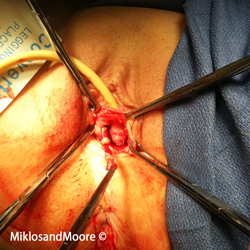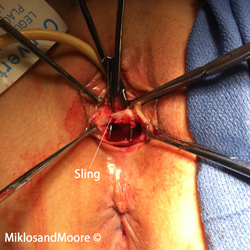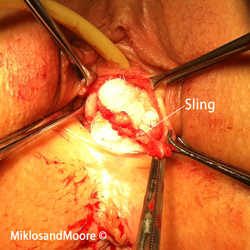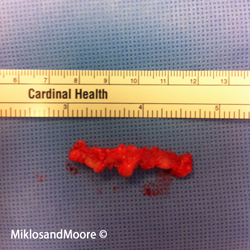Mesh Complications Patient Story 23
Vaginal Pain and Painful Intercourse following TOT Sling
Mesh Complications: Vaginal pain and painful intercourse (aka dyspareunia)
Treatment: Transvaginal approach to removal a portion of the TOT sling
The patient is a 52-year-old woman who had a TOT sling performed in 2007 in Canton, GA. After surgery, she experienced pain and general discomfort in the vagina. Reportedly, the surgeon told the patient she had scar tissue and offered her no viable solutions for her pain and discomfort. The patient subsequently moved to Illinois. She sought further medical treatment.
The patient consulted a pre-eminent urogynecologist in St. Louis who diagnosed her with IC (Interstitial Cystitis). He placed her on various medications (i.e. Elmiron). Her pain continued, and she was referred to a plastic surgeon. She received trigger point injections for the suspected diagnosis of nerve entrapment, which failed to relieve her pain. This plastic surgeon referred her to a fellow plastic surgeon that reportedly said, ōThey are all quacks.ö Referring to gynecologists. The patient was then referred to a world-renowned urologist in St. Louis who specializes in female incontinence. The urologist did not believe the patient had IC. An ultrasound was ordered which revealed a thickening underneath the bladder. The urologist recommended the patient continue her care or follow-up with her urogynecologist.
Comment Drs. Miklos and Moore: When a sling is performed it does not elevate the bladder but instead the urethra. The thickening underneath the bladder is not related to the sling procedure.
The extremely frustrated patient contacted Dr. Miklos by email. Dr. Miklos explained to the patient based on the information she presented; she did not have IC and since she experienced pain after the sling placement the sling was mostly likely causing the pain. The patient came to Atlanta within the month. Examination revealed point tenderness exactly where the sling extends across the vagina underneath the urethra.
The patient was taken to surgery the next day, and an incision was made just underneath the urethra (where the sling was placed). Drs. Miklos & Moore extended the dissection laterally to the vaginal sidewalls, freed up the sling away from the urethra, and cut the sling as laterally as possible. This removed all tension across the ceiling of the vagina and underneath the urethra. The patient spent the night in the hospital. The next day she could already feel less tension and pain relief in her vagina.
Ā
This is the initial dissection of the vaginal skin away from the sling. ĀThe sling has dense scar tissue surrounding it and can be seen running horizontally under the urethra. The sling now needs to be meticulously dissected away from the urethra above. There is SEVERE tension on this sling horizontally, which creates pain for the patient. (The yellow tube is a catheter going into the urethra.)
The sling is completely dissected away from the urethra above and partially away from the sidewalls. ĀHere Dr. Miklos is stretching the sling so one can view the sling more readily.
The sling has been dissected away from the overlying urethra. A gauze patch has been placed between the urethra and the sling to help the viewer identify the sling. ĀAt this point the sling just needs to be released laterally at the vagina sidewalls and this will allow for removal of the vaginal portion of the sling.
Here the vaginal portion of the sling has been completely removed. It measures approximately four cm. or one and half inches. The removal has relieved four long years of this patient's pain.
Click here to find out more about TOT Sling complications.
Click here for related patient stories











